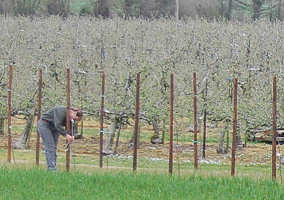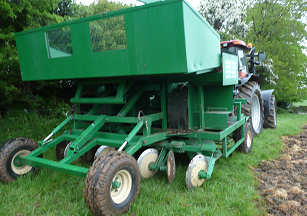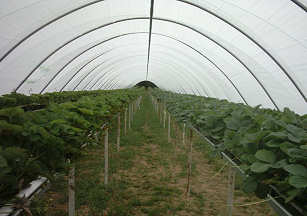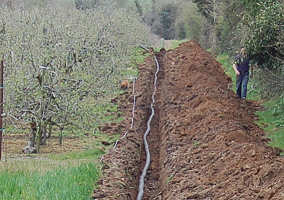| Newsletter Winter 2009 | ||
 |
|
 |
Welcome to our winter newsletter. I would like to wish all our customers and friends a happy Christmas, and a healthy and rewarding 2010.
A busy 12 months
Wow! We have just had a really exciting
year, which I hope goes some way to excusing the fact that this is the
first and last newsletter of 2009. So apologies to all our subscribers;
here’s hoping you enjoy the read despite the long wait.
I think as you read the newsletter you will see just what we have been
busy doing.
A new plum orchard
 One of the most important
things we can do as fruit growers is plant a new crop. For some fruits
like strawberries, they may only last for a few years, but for others,
like apple or plum orchards, they might be there for forty years or
more, so it is important to get it right.
One of the most important
things we can do as fruit growers is plant a new crop. For some fruits
like strawberries, they may only last for a few years, but for others,
like apple or plum orchards, they might be there for forty years or
more, so it is important to get it right.
Last spring we planted some new plum trees; about an acre in total. The
variety we selected is called Opal, which is probably the second-most
reliable plum you can grow in Ireland. (Victoria is probably even more
reliable, but not as tasty a plum in my opinion).
Traditionally Opal plum trees were planted far apart from each other,
as the trees, typically on a rootstock called St. Julian A, grow quite
large, and need a space of at least 5m x 5m in which to grow. The trees
also grow tall, and after a few years a ladder is needed for picking.
While the plums are so tasty to be well worth the climb, it is quite
tricky to get to all of them, and of course the tastiest ones are
always at the top of the tree. Sometimes too, after getting the ladder
and climbing up, you find that the plums are not as ripe as they looked
from the ground. So they must be left for a few more days before they
can be picked. The result is a lot of climbing, which though fun when
you are young, can be a bit tiring after forty years. How often we have
wished that we could have a miniature plum tree, just like we have with
the apples. No ladders, and all the fruits fully exposed to the
sunlight, as the trees would not be tall enough to be very shaded lower
down.
The great news though is that a new dwarfing plum rootstock is now
available, although thus far only for growers. It is called VVA-1 or
also Krymsk-1, and originated in Russia in 1966, having come from a
breeding program commenced in 1956. Krymsk is on the North-Eastern
shore of the black sea, and though really only a provincial town, its
horticultural station holds the largest collection of fruit plants in
any part of Russia or the former USSR, with 9,000 different types of
plums, cherries, peaches and apricots, including 2,500 named varieties.
The story of the breeding of this rootstock is an interesting one. It
is a hybrid bred using natural techniques. Trees of the female parent
Prunus tomentosa from the Moscow garden of the breeder, Dr. Guennadi
Eremin, were planted in an orchard of Prunus cerasifera in Krymsk at
blossom time. The latter trees (known as cherry plum, often grown in
Ireland as spectacular flowering trees for early spring) acted as male
parents donating the pollen which fertilized the female flowers. The
resulting seeds were sown and one of these gave rise to a daughter
which was named VVA-1.
It is considered a unique rootstock of Prunus (plum, cherry, peach
etc.) because its characteristics include resistance to low
temperatures, dwarf habit and ability to serve as rootstock for quite a
number of different species. In 1976, after ten years of observation,
and twenty years after the breeding program commenced, VVA-1 was
released. However, it was not until after the fall of the iron curtain
that the rootstock travelled west, making its way to The Netherlands in
1994, for further testing, and into commercial orchards only in the
last few years, practically forty years after the initial plant was
selected. Dr. Eremin has continued to breed new plant selections, and
as recently as 2005, another of his selections was released for growers
to use. However, it seems likely that VVA-1 will be his most
significant legacy.
It is certainly the rootstock of most interest to us here, as its
ability to keep plum trees small could transform plum growing in
Ireland from a niche interest into something much more mainstream. It
is for this reason that we planted 1200 trees on a single acre last
spring, a planting that would have needed 7 acres using the traditional
rootstocks. We look forward to the fruits of our labours, but also the
much more significant labours of Dr. Guennaddi Eremin and the
state-sponsored research of the now defunct USSR.
In our farm shop
We have our usual range of apples,
including really beautiful Elstar, as well as that traditional
favourite, Karmijn de Sonnaville. Bramley cookers are also available,
as are Golden Delicious. Jonagold will also be available shortly.
Our juices are as popular as ever and really good value, with a case of
12 large bottles of apple juice; enough to keep you going for ages,
only 22 euros.
The sparkling juice is going from strength to strength, with people
coming from all over Ireland to get it.
All the juices also make a great Christmas present, either in a
presentation basket or bag, or with a few fruits.
Planting Elephant Grass
 Another new venture that kept
me busy this spring was planting a 10 acre field of elephant grass. Now
I’m not saying that I personally planted the crop myself; the land was
tilled by local contractor Philip Kiely, and the planting done by
rhizome suppliers Tippgen. However, it somehow still kept me busy.
Elephant grass is a perennial grass which grows up from its roots each
year. It is an amazing plant which in Ireland can grow to ten feet tall
in a single year, but yet requires no fertilizer and is tolerant of
drought. Its attraction in a world of diminishing fuel supply is as a
biomass crop. It can be harvested year after year, and the shoots used
in power stations in place of peat, or in homes and industry in place
of coal, oil and gas. Because it is practically carbon neutral, it not
only offers the hope of a new more-reasonably priced alternative to
fossil fuels, but its cost need not rise in line with oil prices,
especially if these escalate rapidly as happened almost two years ago.
In addition, it does not contribute to global warming, and indeed,
research is currently under way to investigate if the carbon trapped in
the tap roots might even act as a carbon sink, taking harmful carbon
dioxide out of the atmosphere. I planted this crop because I feel that
as a user of fuels in my daily life (whether driving to town or heating
my home), I ought to use the opportunity presented by being a farmer to
reduce carbon outputs and become involved in making a positive
contribution towards lowering Ireland’s massive energy bill, most of
which is spent on importing fossil fuels (the last time I checked,
Ireland spent 7 billion euros a year on imported fuels. If we could
keep even half of that in Ireland it would solve so many of our
financial woes). From a growers perspective, the ten acres will produce
about 100 tons of dry matter each year. While that is far more than I
would require for personal use, the crop will be purchased by Tippgen,
who in turn will use it to supply to their local energy customers. It
just seems like such a sensible way to operate. Local energy crops for
local energy use.
Another new venture that kept
me busy this spring was planting a 10 acre field of elephant grass. Now
I’m not saying that I personally planted the crop myself; the land was
tilled by local contractor Philip Kiely, and the planting done by
rhizome suppliers Tippgen. However, it somehow still kept me busy.
Elephant grass is a perennial grass which grows up from its roots each
year. It is an amazing plant which in Ireland can grow to ten feet tall
in a single year, but yet requires no fertilizer and is tolerant of
drought. Its attraction in a world of diminishing fuel supply is as a
biomass crop. It can be harvested year after year, and the shoots used
in power stations in place of peat, or in homes and industry in place
of coal, oil and gas. Because it is practically carbon neutral, it not
only offers the hope of a new more-reasonably priced alternative to
fossil fuels, but its cost need not rise in line with oil prices,
especially if these escalate rapidly as happened almost two years ago.
In addition, it does not contribute to global warming, and indeed,
research is currently under way to investigate if the carbon trapped in
the tap roots might even act as a carbon sink, taking harmful carbon
dioxide out of the atmosphere. I planted this crop because I feel that
as a user of fuels in my daily life (whether driving to town or heating
my home), I ought to use the opportunity presented by being a farmer to
reduce carbon outputs and become involved in making a positive
contribution towards lowering Ireland’s massive energy bill, most of
which is spent on importing fossil fuels (the last time I checked,
Ireland spent 7 billion euros a year on imported fuels. If we could
keep even half of that in Ireland it would solve so many of our
financial woes). From a growers perspective, the ten acres will produce
about 100 tons of dry matter each year. While that is far more than I
would require for personal use, the crop will be purchased by Tippgen,
who in turn will use it to supply to their local energy customers. It
just seems like such a sensible way to operate. Local energy crops for
local energy use.
Spanish tunnels
 During what we called our
“summer” we were busy with the Spanish tunnels. If you have a look at
our website, you will see an aerial photograph showing them. They are
low-tech tunnels which are large enough to walk into, and in these we
grow cherries, raspberries and strawberries, and from next year
hopefully some plums too. While the majority of our strawberries,
raspberries and plums are grown outdoors, this is not really possible
for cherries, as the weather tends to be too cool at flowering, and too
wet during the summer. It is really convenient to have some tunnels for
the soft fruit also, as if the forecast is for wet weather one day and
dry another, we can organize to harvest the indoor fruit on the wet
day, and the outdoor fruit on the dry day. It really suits everyone
like this, because on a nice summer day we all like to be out, but if
it’s wet, the protection of the covers is much appreciated. The tunnel
design originated in Spain, which is how they got their name. They are
not suited to stormy weather though, so in the autumn we take off the
plastic covers, and in the spring we put them back on again. That is a
tricky job, as it is vital that there is not the slightest breeze, as
the huge section of plastic first needs to be put in place, and then
tied down. Even a little wind when doing this job could lift the
plastic (and all who hold onto it) high into the sky. Thus far though,
we have always managed to pick a calm morning for the job; a skill I
hope that we can repeat again next year.
During what we called our
“summer” we were busy with the Spanish tunnels. If you have a look at
our website, you will see an aerial photograph showing them. They are
low-tech tunnels which are large enough to walk into, and in these we
grow cherries, raspberries and strawberries, and from next year
hopefully some plums too. While the majority of our strawberries,
raspberries and plums are grown outdoors, this is not really possible
for cherries, as the weather tends to be too cool at flowering, and too
wet during the summer. It is really convenient to have some tunnels for
the soft fruit also, as if the forecast is for wet weather one day and
dry another, we can organize to harvest the indoor fruit on the wet
day, and the outdoor fruit on the dry day. It really suits everyone
like this, because on a nice summer day we all like to be out, but if
it’s wet, the protection of the covers is much appreciated. The tunnel
design originated in Spain, which is how they got their name. They are
not suited to stormy weather though, so in the autumn we take off the
plastic covers, and in the spring we put them back on again. That is a
tricky job, as it is vital that there is not the slightest breeze, as
the huge section of plastic first needs to be put in place, and then
tied down. Even a little wind when doing this job could lift the
plastic (and all who hold onto it) high into the sky. Thus far though,
we have always managed to pick a calm morning for the job; a skill I
hope that we can repeat again next year.
Irrigation
 With the weather we have had
for the last three summers, and the incessant rain of recent times, I
am almost embarrassed to write about our irrigation project. However,
over the past few years, we have been expanding the area of crops that
we can supply water to. In December 2004, I wrote about boring for
water on our farm, and each year since then, we have added a little to
our water infrastructure.
With the weather we have had
for the last three summers, and the incessant rain of recent times, I
am almost embarrassed to write about our irrigation project. However,
over the past few years, we have been expanding the area of crops that
we can supply water to. In December 2004, I wrote about boring for
water on our farm, and each year since then, we have added a little to
our water infrastructure.
The reason that we decided to build this infrastructure is due to the
climate change models, which show South East Ireland having hotter and
drier summers, as well as milder and wetter winters. The latest edition
of the book “Climate, Weather and Irish Agriculture” goes into great
detail, but suffice to say that if it is correct, summers will have dry
spells long enough to put crops under stress from lack of water. And as
farmers, our job is to minimise the stress on our plants, so that they
can perform at their best.
So this summer and autumn we expanded the on-farm network to cover
another two apple orchards, as well as the new plum trees I mentioned
earlier. It really felt odd to be doing this work when the current
weather did not warrant it. However, the climate models are actually
gaining more credibility all the time, so I can only conclude that our
last three wet summers were down to hard luck. Here’s hoping that the
next one will be better. We can all do with the lift that a few weeks
of sunshine brings.
A new award
We were honoured to
receive an award from Euro Toques, the European organisation of Chefs.
It came about after we received a visit from one of their chefs
(although I was unaware of the purpose of his visit at the time) and I
showed him around the farm one autumn morning, giving him samples of
some of our apples, and generally explaining what we do. A few weeks
later I received a letter from EuroToques, informing me that I was to
receive one of their annual awards for producers. And when I went to
receive the award about two weeks ago, who was there but Peter Everett,
the chef from “Residence” who had visited me during the autumn. Also
there were many other well known people such as Derry Clarke and Ross
Lewis, both of whom have Michelin stars, Myrtle and Darina Allen, and
so many more. I was especially happy to receive the award from Neven
Maguire, who uses our juice in his restaurant in Blacklion, Co. Cavan.
The award was given “In recognition of excellent quality standards,
traditional and artisan production methods, and outstanding
contributions to Irish food.”
And to top off a really exciting day, we had samples of all sorts of
wonderful dishes, prepared using the food produced by the award-winners.
Web links:
www.eurotoquesirl.org
www.macneanrestaurant.com
www.chapteronerestaurant.com
www.lecrivain.com
www.residence.ie
A book launch
During November I received an
invitation to a book launch from one of our juice customers, Carmel
Somers of Good Things Café in Durrus, West Cork. Carmel operates one of
Ireland’s most celebrated cafés and also has a cookery school. I was so
pleased to be invited that I offered to supply some juice for the
launch, which in turn meant that I had no option but to accept the
invitation.
Carmel’s book, “Eat Good Things Every Day” has been brought home, and
having already tried one of the straight-forward dishes, I can attest
to the excellence of the food prepared using her tips and recipes.
Available from usual outlets and at www.thegoodthingscafe.com
Miracle of Apple Juice
So said the front
page headline of the Daily Express on January 24th last. The article
went on to describe the research published in the Journal of
Alzheimer’s Disease, which showed that mice who consumed the human
equivalent of two glasses of apple juice each day did not suffer the
normal decline in brain function associated with aging. Dr. Thomas
Shea, of the Centre of Neurobiology in Massachusetts also found that
the mice who were fed the apple juice produced less beta-amyloid
protein in their brains. This is important because beta-amyloid is
responsible for forming the sticky plaques in the brain that are
commonly found in people suffering from Alzheimer’s.
